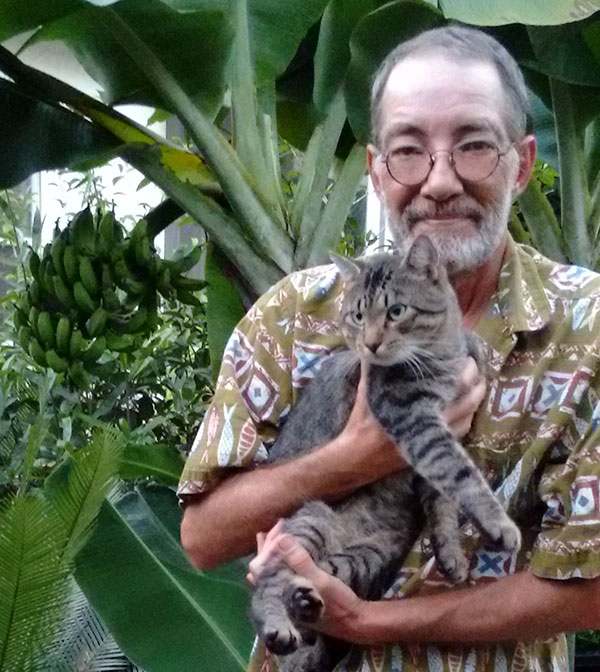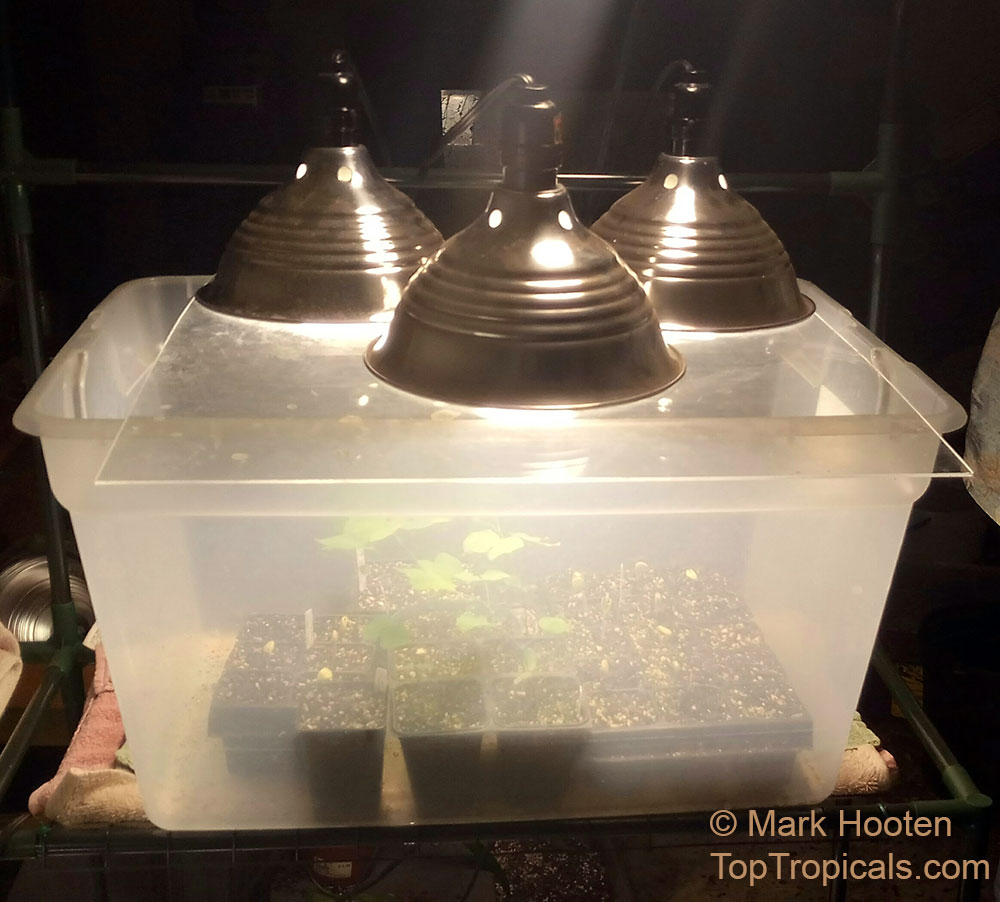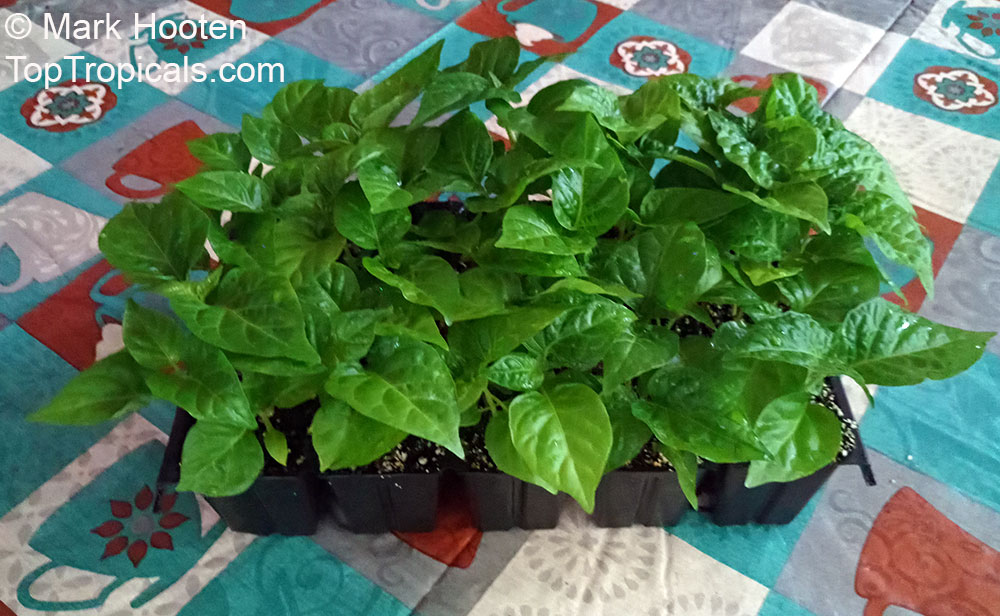How to quickly germinate tropical seeds in winter
by Mark Hooten, the Garden Doc
 About the Author
About the Author
Mark Hooten has been fascinated by horticulture since childhood, with interests including tropical fruits, cacti, ethnobotany, entheogens, and variegates. Having been employed in both FL and CA by botanical gardens and specialist nurseries as horticulturist, manager, propagator, and consultant, he is happy to speak with fellow plant worshipers at TopTropicals Nursery. Mark is currently busy writing a volume on the complicated history of croton varieties. His passions are plants, cats, and art of painting.
Q: I live in the New England area where the winters are very long and dreary. I plant both a veggie and flower garden during the warmer seasons and am especially fond of growing chili-peppers. On account of most chili's longer growing seasons, I need to get already established plants in the ground as soon as the weather is warm enough. My problem is that despite my best attempts to germinate and grow seedlings ahead of time—even in my sunniest window—I just can't seem to keep the soil evenly warm enough to get them to germinate, no matter how warm the room is kept. And on the occasion they do come up, the seedlings always seem to remain weak and stunted, likely owing to the especially low humidity of winter. I also tried using an electric seed-starting heating pad, and the results were only a little better. Are there any tips you could give me?
A: YES, I understand your issues and can sympathize! While it might be surprising to some, even here in sunny S.W. Florida, there are long stretches of winter weather where the ambient temperatures are simply too cold for germinating many of the more tropical seeds, such as the notoriously warm-weather chili-peppers. Also, I am likewise a fan of chilis, and always have at least a few different kinds growing at any given time. I have two great suggestions:
1. Grow-box
The first is to use my simple "grow box" technique. The few necessary materials are not complicated. You can begin by using anything from an unused aquarium to a clear plastic storage box. I actually now prefer the latter because they are so light-weight (and cheap). I mostly use storage boxes with a size of about 20" by 16", and 12" to 14" deep. The depth is more important.
Then, place an appropriately-sized clear plexiglass sheet on top of the box. (You can get all these things at most big box stores as well). Then you will need 2 or 3 - I prefer 3 - grow lamps, to be placed directly on top of the plexiglass covering. These can be cheaply fashioned out of widely-available 'clamp lights with reflector', from which I usually remove the clamp, and using a 'soft white' 2700-3000K 23W (100W incandescent equivalent) compact fluorescent bulb. Following much experimentation, I have found these to be the best widely available bulbs, likely owing to their emission spectrum closely matching that liked by most plants (counter-intuitively, better so than 'daylight' white bulbs); and using only a modest 70 watts of power altogether. I've included an image so you'll see what I mean.
see also: article on plant lighting and more info on grow lights
You'll want to keep the lamps on for at least 16 to 18 hours per day. Because I can't trust myself to always do that manually, I plug the lamps into an inexpensive 24 hour mechanical timer, also from the box store. The ambient heat created by the lamps sitting on top is generally the perfect environment for germinating warm-soil things such as chili seeds, even when the surrounding air temperature is considerably colder. I also sometimes place a thermometer in the box, just to make sure it doesn't go much above 90 degrees. If it does, simply slide the plexiglass top a bit to the side and allow the extra heat to vent out. Plus, the covered top maintains high humidity.
To illustrate just how well this system works, I have included an image, taken just a couple of days ago, of a seed tray I've grown of the rare 'Bhut Jolokia' chili, the genuine "white fruited ghost pepper". These are notoriously difficult to germinate, and were planted less than 2 months ago. However, once planted and placed in the grow box, it took less than 2 weeks for virtually every seed to germinate! This is almost unheard of in the habanero-type chili world.
2. Sunshine-Epi
My second suggestion for germinating difficult seeds of ALL kinds, is to use Top Tropicals special formula called Sunshine-Epi. While the last thing I want to sound like is a commercial (ugh!), I have found that either pre-soaking larger seeds, or simply watering recently planted smaller seeds with this solution enhances germination rates beyond my wildest expectations. Within the past few months, using the Sunshine-E formula, the germination rates of seeds I have always had difficulty with have risen to nearly 100 percent! The image of the tray of 'Bhut Jolokia' chilis shows this very clearly. They have also been sprayed with the solution every few days. This is very special stuff, and I highly recommend it!



